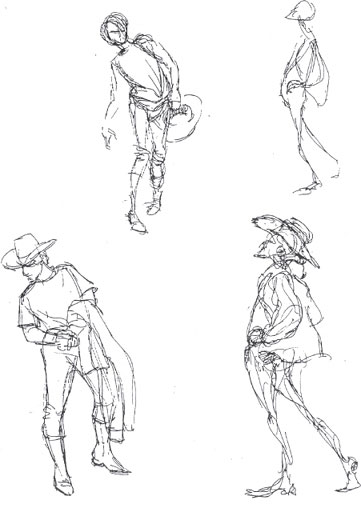Every artist must know the basic structure of the human body (animals, too) and how the parts work in action. These bodily movements are what all mankind uses for gestural expression. You shrug your shoulder to indicate doubt, not knowing, or resignation. And to complete the gesture you raise your eyebrows, the corners of your mouth curl up, and your cheeks puff up causing your eyes to squint. You duck your head to accent the uplifted shoulders. The structure of your torso, shoulders, and face are the parts you use for the action. You twist around, squint, and cup one hand over an ear in a listening attitude. Again, you must know how the body parts work; their capabilities, and their limitations to convincingly draw that action. Even so, every person (character) having a different personality; a slightly different body structure, or enacting the move for a different purpose or in a different attitude, all require a sensitive use of an otherwise mechanical action. You are naturally interested in the mechanics of anatomy, for that is an important tool used in drawing and animation. But you are also interested in storytelling, so it is important to sensitize yourself to the established forms of body communication.
Knowledge of basic anatomy is necessary to adequately portray the gestures. After all, in the overall development of mankind, the physical body came first and the gestures only after our brains developed to where they had to invent a means of dramatizing our thoughts. There ensued an almost universal language of body gesture. Everyone uses body language according to their physiological makeup and their personality. The artist (you) has to be able to capture any number of gestures and actions depending on the needs of the story and character,
In the Tuesday and Wednesday evening classes we attempt to carry drawing a step beyond just copying the pose. We try to fuse the anatomical model with a gestural “story,” wherein the various parts of the body supply the fine-tuning for the overall gesture. In other words, what does the body have to do to accomplish this or that gesture? The study serves two purposes. First, the study perfects our facility in drawing, and secondly it is in a sense studying acting, so that when we are faced with an acting problem (for animation) we can skillfully merge the two purposes together into a first rate drawing or scene, one that is well-drawn and well-acted.
I saved some drawings from a recent class that might help to illustrate the kind of reasoning that one might undergo (and nurture) to accomplish that goal. In the first drawing the model was carrying a coat over his right shoulder. I reasoned that to keep the coat from slipping off, he would lift that shoulder higher. In thinking through such actions, if there are any doubts in your mind, be the pragmatist and assume the action yourself to get the feel of it. You certainly want to be authentic in any gesture you use. When the right shoulder is raised, the body adjusts by raising the left hip. Not only does it establish the pose as genuine but it also adds more dynamism to the drawing.
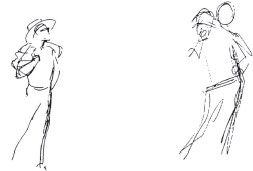
The second example is the same problem only by a different artist. This neglect to “enter into the spirit” of the gesture seems to be universal.
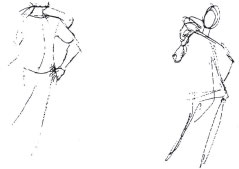
In the third drawing the problem is similar. Again, the body does certain things to produce certain body language. Every drawing you make should go through your action analysis computer to make sure whatever you put down will be convincing to the viewer. In this drawing I reasoned that he could have his thumb tucked in his belt and could be pushing down (typical western pose) while the shoulders and hips do their usual thing. In doing so I eliminated the duplication of angles in the two arms. And, when your shoulders tilt to the left, your head tends to tilt to the right.
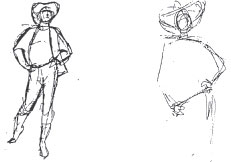
In the fourth drawing the problem was increased by having to draw the angle of the shoulders from the side. Telling yourself that the right shoulder is lower than the left is one clue to the solution.
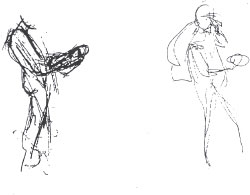
In the fifth drawing the problem was similar. Again I used the angles of the shoulder and hips to do away with the duplication of angles on both arms, and to tilt the head in opposition to the shoulder angle. Another common error is to tilt the hips but still have the upper leg connections level.
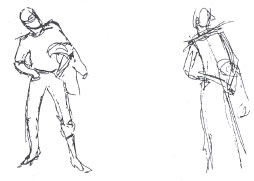
These corrections are not meant to infer that there is just one right way to draw something. The point is that all actions should be done in a logical way, both physically and gesturally to get the maximum impact or impression out of the drawing. Naturally, great liberties can be taken to accomplish a desired effect. It can be an impossibility as far as real life authenticity is concerned, but it has to seem logical. The more cartoony or caricatured the character is, the more wild the action can be and the more liberties may be taken to affect it.
I couldn’t resist adding a page of drawings that needed no correction. These are delightfully expressive. Lots of nice angles, no parallels, no tangents. Outstanding analysis of the poses. In a word — extraordinary.
